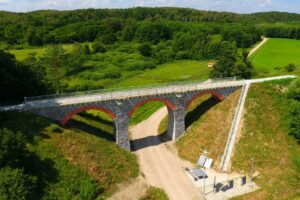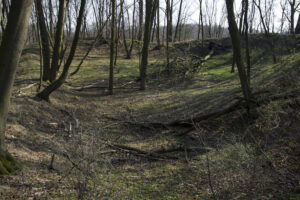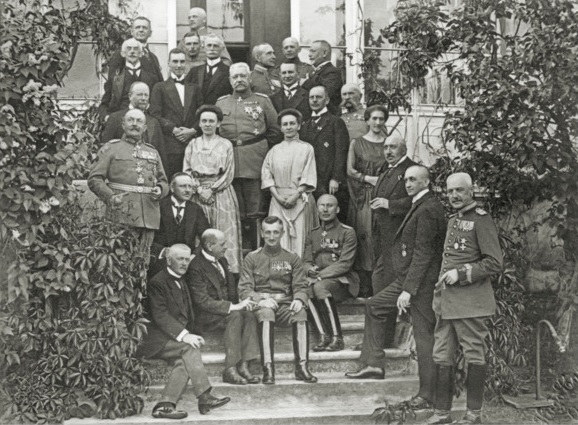Western Masuria
WZGÓRZA DYLEWSKIE.
Masurian Mountains
Dylewskie Hills is a picturesque region in Western Masuria, which delights with its natural beauty and rich history. Dylewskie Hills is a part of the Dylewskie Hills Landscape Park (Park Krajobrazowy Wzgórz Dylewskich), which includes several nature reserves, such as Dylewska Góra, Góra Bukowa and the lakes of Rumian and Francuskie.
The park features a variety of flora and fauna, including rare plant and animal species, as well as mouflons, which were brought here in the 1970s.
You can also visit historic courts and manors of the Prussian landed gentry (in Polish: “siedziby junkierskie”, from “junkrzy” - a noble social class originating from the end of the Teutonic Knights' rule in Prussia) which bear witness to the region’s culture and traditions. You can also see the observation tower on Dylewska Góra which offers beautiful and unforgettable views of the area.
Dylewskie Hills is also a paradise for lovers of active leisure. There are numerous hiking, biking and horseback riding trails that lead through picturesque landscapes. Meanwhile in winter, it’s a perfect place to go cross-country skiing.
Highest point
Area of the park
Date of establishment




About the
DYLEWSKIE HILLS.

Flora and fauna
Dylewskie Hills is one of the few places in Poland and Europe where you can encounter mouflons, which are not indigenous to these lands, as they are native to Corsica.
The Park is also home to many other unique, precious and interesting animal species, including 6 protected species of beetles, 5 protected species of bumblebees and 3 protected species of day butterflies. In the area of the park, 10 species of amphibians, 4 species of reptiles, 105 breeding and probably breeding bird species and 25 species of mammals were documented as well.
A total of 236 species have been found, 168 of which are protected species. Despite the fact that the park’s area is heavily transformed for agricultural use, the list of animal species found here is long and interesting, especially the species of day butterflies and birds. Three species found in the area are endangered in the Polish Red Book of Animals (“Polska Czerwona Księga Zwierząt”): otter, wolf and lesser spotted eagle.
The park is also an important site for the brenthis daphne, which is an endangered species, as well as for other endangered species of day butterflies. The population of mouflons, which were introduced before the park was established, has grown to about 75 individuals that mainly inhabit the areas around Jagodzin, Wygody, Glaznoty and Wierzbica.
Attractions in the area

Glaznoty
Where a historic Evangelical church (now Methodist) from the 14th century is located. It’s a catholic church, built at the turn of the 19th and 20th century. There’s also a railway viaduct from 1909, which is an architectural marvel of the now-defunct Działdowo-Ostróda railroad route. In 1945, most of the tracks were disassembled and taken away by the Soviets.
See on map

Sassenpile
Where, according to the legend, the capital of the Prussian Sasna tribe was located. The fortified settlement is located on the edge of the Gizela River valley, about 1.2 km south of the village of Zajączki. The site is surrounded by an embankment of a height of 8 meters. The fortified settlement was created by cutting off the southeastern part of the hill, on which it is founded, with a deep trench, which served as a dry moat, still perfectly visible today. In the western part of the wall, there is a clearly visible decline, which is probably a remnant of the entrance gate.
See on map

Szlak Siedzib Junkierskich (Prussian landed gentry’s Residences Trail)
The cycling trail on the Dylewskie Hills is a 42 km long trail leading to the residences of former estates of the Prussian landed gentry (“Junkrzy” in Polish) and introduces visitors to the history of their owners. The route is equipped with information panels located in the most important locations of the trail. It’s worth traversing the trail by car or bicycle, because of the history of these people – owners of lands from the eastern basin of Łaba (Prussia, Mecklenburg and Holstein). Their estates were notable for their high level of management and mechanization of agricultural work.
Fun facts

Geological lapidarium
The lapidarium (a place where stone monuments and fragments of archaeological interest are exhibited) was established in 2015 near Dylewska Góra, on the route of the Dylewska Góra nature trail. It currently showcases more than 30 specimens of erratic boulders most characteristic of the entire Dylewskie Hills region.
In addition to informational panels placed at the site, the most interesting boulders have been equipped with individual informational plates, each with a QR code and a map of how a given specimen has arrived in the Dylewskie Hills.
See on map

Francuskie Lake
Francuskie Lake is a small, mid-forest lake.
According to a legend, during the Napoleonic campaign, peasants drowned several Frenchmen in the lake in retaliation for harm done to a local girl, hence the name French Lake (Francuskie Lake).
See on map

Zajączki
In the nearby cemetery, located about 1 km from the village, on the road to Glaznoty, the Kramer family burial chapel from the mid-19th century has been preserved..
